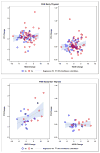Association between change in serum bicarbonate and change in thyroid hormone levels in patients receiving conventional or more frequent maintenance haemodialysis
- PMID: 29064128
- PMCID: PMC5916580
- DOI: 10.1111/nep.13187
Association between change in serum bicarbonate and change in thyroid hormone levels in patients receiving conventional or more frequent maintenance haemodialysis
Abstract
Aim: Correction of metabolic acidosis in patients with chronic kidney disease has been associated with improvement in thyroid function. We examined whether changes in bicarbonate were associated with changes in thyroid function in patients with end-stage renal disease receiving conventional or more frequent haemodialysis.
Methods: In the Frequent Hemodialysis Network Trials, the relationship between changes in serum bicarbonate, free triiodothyronine (FT3) and free thyroxine (FT4) was examined among 147 and 48 patients with endogenous thyroid function who received conventional (3×/week) or more frequent (6×/week) haemodialysis (Daily Trial) or who received conventional or more frequent nocturnal haemodialysis (Nocturnal Trial). Equilibrated normalized protein catabolic rate (enPCR) was examined to account for nutritional factors affecting both acid load and thyroid function.
Results: Increasing dialysis frequency was associated with increased bicarbonate level. Baseline bicarbonate level was not associated with baseline FT3 and FT4. Change in bicarbonate level was not associated with changes in FT3 and FT4 in the Daily Trial nor for FT4 in the Nocturnal Trial (r ≤ 0.14, P > 0.21). While, a significant correlation between change in serum bicarbonate and change in FT3 (r = 0.44, P = 0.02) was observed in the Nocturnal Trial; findings were no longer significant after adjusting for change in enPCR (r = 0.37, P = 0.08). For participants with baseline bicarbonate <23 mmol/L, no association between change in bicarbonate and change in thyroid indices were seen in the Daily Trial; for the Nocturnal Trial, findings were also not significant for change in FT3 and the association between change in bicarbonate and change in FT4 (r = 0.54, P = 0.03) was no longer significant after adjusting for enPCR (r = 0.45, P = 0.11).
Conclusion: Changes in bicarbonate were not associated with changes in thyroid hormone levels after adjusting for enPCR, as a marker of nutritional status. Future studies should examine whether improvement in acid base status improves thyroid function in haemodialysis patients with evidence of thyroid hypofunction.
Keywords: bicarbonate; equilibrated normalized protein catabolic rate; haemodialysis; hypothyroidism; metabolic acidosis; thyroid function.
© 2017 Asian Pacific Society of Nephrology.
Conflict of interest statement
All the authors declare no conflict of interest
Figures


Similar articles
-
Thyroid function in end stage renal disease and effects of frequent hemodialysis.Hemodial Int. 2017 Oct;21(4):534-541. doi: 10.1111/hdi.12527. Epub 2017 Mar 16. Hemodial Int. 2017. PMID: 28301073 Free PMC article.
-
Longitudinal and cross-sectional effects of C-reactive protein, equilibrated normalized protein catabolic rate, and serum bicarbonate on creatinine and albumin levels in dialysis patients.Am J Kidney Dis. 2003 Dec;42(6):1200-11. doi: 10.1053/j.ajkd.2003.08.021. Am J Kidney Dis. 2003. PMID: 14655192
-
Prevalence of malnutrition-inflammation complex syndrome and its correlation with thyroid hormones in chronic haemodialysis patients.Nefrologia (Engl Ed). 2018 Jan-Feb;38(1):57-63. doi: 10.1016/j.nefro.2017.07.001. Epub 2017 Oct 26. Nefrologia (Engl Ed). 2018. PMID: 29102271 English, Spanish.
-
Correction of metabolic acidosis to ameliorate wasting in chronic kidney disease: goals and strategies.Semin Nephrol. 2009 Jan;29(1):67-74. doi: 10.1016/j.semnephrol.2008.10.009. Semin Nephrol. 2009. PMID: 19121476 Review.
-
Bicarbonate Balance and Prescription in ESRD.J Am Soc Nephrol. 2017 Mar;28(3):726-734. doi: 10.1681/ASN.2016070780. Epub 2016 Nov 23. J Am Soc Nephrol. 2017. PMID: 27881607 Free PMC article. Review.
Cited by
-
[What is confirmed in the treatment of metabolic acidosis in chronic kidney disease?].Inn Med (Heidelb). 2024 Dec;65(12):1209-1215. doi: 10.1007/s00108-024-01806-z. Epub 2024 Nov 8. Inn Med (Heidelb). 2024. PMID: 39514096 Free PMC article. Review. German.
-
Patient Survival With Extended Home Hemodialysis Compared to In-Center Conventional Hemodialysis.Kidney Int Rep. 2023 Sep 15;8(12):2603-2615. doi: 10.1016/j.ekir.2023.09.007. eCollection 2023 Dec. Kidney Int Rep. 2023. PMID: 38106580 Free PMC article.
-
Interventions for fatigue in people with kidney failure requiring dialysis.Cochrane Database Syst Rev. 2023 Aug 31;8(8):CD013074. doi: 10.1002/14651858.CD013074.pub2. Cochrane Database Syst Rev. 2023. PMID: 37651553 Free PMC article. Review.
References
-
- Muscaritoli M, Molfino A, Bollea MR, Rossi Fanelli F. Malnutrition and wasting in renal disease. Curr Opin Clin Nutr Metab Care. 2009;12:378–83. - PubMed
-
- Iglesias P, Díez JJ. Thyroid dysfunction and kidney disease. Eur J Endocrinol. 2009;160:503–15. - PubMed
-
- Koo HM, Kim CH, Doh FM, et al. The impact of low triiodothyronine levels on mortality is mediated by malnutrition and cardiac dysfunction in incident hemodialysis patients. Eur J Endocrinol. 2013;169:409–19. - PubMed
-
- Wiederkehr MR, Kalogiros J, Krapf R. Correction of metabolic acidosis improves thyroid and growth hormone axes in haemodialysis patients. Nephrol Dial Transplant. 2004;19:1190–97. - PubMed
Publication types
MeSH terms
Substances
Grants and funding
- U01 DK066579/DK/NIDDK NIH HHS/United States
- NCT00264758/The Frequent Hemodialysis Network Trials
- Baxter
- NCT00271999/The Frequent Hemodialysis Network Trials
- R01 DK076165/National Institutes of Health
- U01 DK066481/National Institutes of Health
- Centers for Medicare and Medicaid Services
- R01 DK076165/DK/NIDDK NIH HHS/United States
- DaVita
- Amgen
- U01 DK066480/DK/NIDDK NIH HHS/United States
- U01 DK066480/National Institutes of Health
- Renal Research Institute and Satellite Healthcare
- National Institutes of Health Research Foundation
- U01 DK066481/DK/NIDDK NIH HHS/United States
- U01 DK066579/National Institutes of Health
- Fresenius Medical Care North America
- National Institute of Diabetes and Digestive and Kidney Diseases
- U01 DK066597/National Institutes of Health
- U01 DK066597/DK/NIDDK NIH HHS/United States
- Dialysis Clinics, Inc.
LinkOut - more resources
Full Text Sources
Other Literature Sources
Medical

